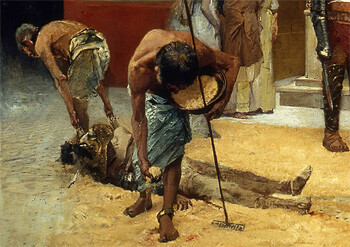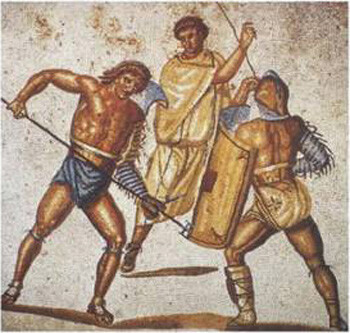10 Ways Gladiator Life Was Different From The Movies

Sometimes, "get rich or die trying" is more than just a motivational figure of speech, and sometimes real-life doesn't match the movies. Sharpen those swords, make peace with Jupiter and get ready for the roar of a bloodthirsty crowd because we are going back in time to Ancient Rome to win glory in the arena ...
They Didn't Live Too Long
Bit of a downer way to start, huh? Well, either way, it does make sense. If your entire shtick is fighting to the death for a living, luck's eventually bound to run out. And according to researchers, luck typically ran out when a gladiator was around 27 years old.

Much like a modern-day MMA fighter, a gladiator would usually fight about two to three times a year, and the odds of survival after so many fights just kept getting lower. On the bright side, though, while Romans could live as long as people today, the average life expectancy of a regular civilian was around 25, so maybe it was better to be a gladiator?
Not All Fights Ended In Death
Hollywood makes it seem like every fight ended in a rolling head, but this wasn't the case. If a gladiator was defeated but still alive, it was up to the sponsor of the game, a wealthy hotshot, to determine their fate. If the fighter was famous enough or if the crowd seemed to enjoy the fight, then the gladiator would be allowed granted stans missus, which means "sent away standing."

This was done for a few reasons. First off, if a sponsor had a popular gladiator killed, the crowd would not be happy, and an unhappy crowd could genuinely ruin a sponsor's political career. There was a logistical issue too. Training a new gladiator took a lot of time and money, so it was honestly more convenient for everyone involved to just leave the loser alive.
A Majority Of Gladiators Were Slaves …
Rome had a lot of slaves. Slaves worked around the homes of the rich Romans and built the architectural marvels that Rome is remembered for today. Some Roman slaves were prisoners of war from the vast territories conquered by Rome. Others were born into slavery from generations of slaves. Some of these slaves, for better or worse, were turned into gladiators.

Universal Pictures
This seems like the cruelest fate a person could get, but there's an argument to be made that if you were a Roman slave, this would be the life to live. Rich Romans staked a lot of their reputation in putting on impressive gladiator shows, which meant that money was invested into gladiators. They had training, a proper diet, and even celebrity status if they were good enough. Because of this, they marked a strange place in the social hierarchy where they were slaves who were in constant danger, but they also had relatively okay lives by Roman slave standards.
... But Some Chose To Become Gladiators
Let's say that you were having a Roman mid-life crisis (which probably occurred at age 18 due to the whole "low life expectancy" thing), or maybe you watched a gladiator fight recently and thought, "I could do that." Well, put up or shut up, because you could fight in the arena if you wanted! A free Roman could take an oath and become an auctorati, a volunteer gladiator. This was seen as a highly shameful thing to do because taking the oath effectively turned a citizen into a slave. So if that was the case, then why would anyone do it in the first place?

via Wiki Commons
Well, some did it out of a sort of necessity. If a Roman was broke and had no way to make money, the life of a gladiator might not be too bad. Again, gladiators had guaranteed food and shelter, and if they won enough, they could earn their freedom back. Others did it for the glory. Rome had a weird relationship with gladiators. On the one hand, they were slaves, which meant they were the lowest in Roman society. But on the other hand, they were celebrities whom the public loved. A winning gladiator could become one of the most famous individuals around.
Not All Gladiators Were Men Either
Listen up! Women can slaughter each other for a crowd's amusement just like men. Rome was a highly patriarchal society with strict gender roles, and it was expected that only men would fight in gladiator arenas. However, there is a lot of evidence from ancient writers to show that there were women gladiators. They weren't common at all, and when women did fight in the arena, it was seen as something special or exotic, a treat for when regular blood and guts got boring.
Alas, men had to ruin this too. In AD 200, Emperor Septimius Severus banned any woman from gladiatorial combat. This came after growing concern that elite Roman women would want to volunteer to fight.

Gladiators Were Like Pokemon; They Had Types
The word "Gladiator" is an umbrella term used to describe every person who fought to the death in Ancient Rome, but each gladiator was more specifically identified by his type, which meant the armor he wore, the weapons he wielded, and the style he fought with. For example, the Thraex, named after the Thracian people, always carried a small shield and a curved dagger called a sica. The Murmillo had a gladius sword, a rectangular shield, and an arm guard. The Retiarius was armed with a trident and a net to simulate a fisherman.

via Wiki Commons
Gladiator shows were advertised by which types were going up against one another, and the Romans loved to see the advantages and disadvantages of each type in a matchup. It was kind of like watching a Pokemon battle. A fire type would get annihilated by a water type ... which made it even more enticing to watch.
Crowds Didn't Want To See Sad Faces
A common trait among almost every type of gladiator is that they wore a helmet that covered their faces. This was done for protection … but not for the gladiator. There was always a sort of weird dichotomy in the arena where crowds wanted to watch men kill each other, but they didn't so much like to see their pained facial expressions. Gladiator games organizers got around this by covering the dudes' heads. They felt a lot less human in these helmets, which allowed the crowd to get invested without having to think of those pesky "morals."

There was one exception to this though, which was the Retiarius, the guy with the net. Retiarii didn't have any sort of helmet, and for some reason, the Romans liked to see their faces.
Gladiators Were Unionized
Another appealing aspect of life as a gladiator was the sense of brotherhood they shared. Yeah, sometimes they had to kill each other for no other reason than because a rich dude turned his thumb the wrong way, but outside of that, they had a bond with one another. This bond could be seen in the unions that they created, known as collegia.

via Wiki Commons
Gladiator unions ensured that each fallen gladiator had a proper burial, and the unions themselves paid for memorials. Because gladiators were slaves or generally of lower status, Roman society considered them shameful in a lot of ways, so collegia made sure that they were given basic respect.
The Elites Hired Them As Bodyguards
Rome was a dangerous place, even for the rich and the powerful. Step out of line or trust the wrong guy, and suddenly you're Julius Caesar on the Ides of March. A logical way to protect yourself was to go to the local gladiator school and hire one of the fighters as a bodyguard. Because they weren't soldiers and likely weren't connected with any other factions or politicians, Romans sometimes believed that gladiators were less likely to betray them than more traditional guards. Plus, because gladiators were often quite popular, it honestly just looked cool to walk around with them. Name a better entourage. You can't.
There was also a more scandalous layer to this. Despite being shamed for their enslaved status, Gladiators were seen as major sex symbols in Roman society, so you can imagine why else someone might want to hire one.

Gladiator Fandom Was REAL
Thank you to Mount Vesuvius for perfectly freezing the city of Pompeii in time because it gave us a glimpse into Roman daily life, and one thing that Pompeii highlights is just how much the Romans loved their gladiator fights. Graffiti left behind on Roman walls shows that not only did Romans cheer gladiators in the arena, but they also followed them similarly to how people follow sports now. Inscriptions show that fans kept track of how many fights a gladiator had, what their type was, and even if they were right or left-handed.

Rome was a violent place, so it's not too surprising that their preferred form of entertainment was guys stabbing each other to death in an arena. The culture around gladiatorial fights wasn't just on the fringes of Roman society either. The fights were to Rome as football is to America, just with more violence and fewer concussions.
Top Image: DreamWorks Pictures